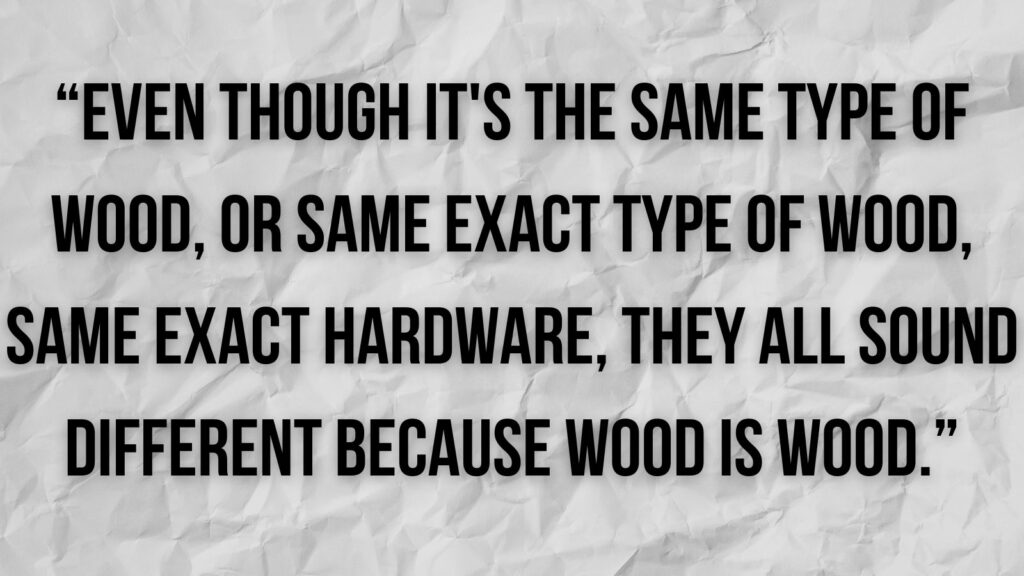Jazz fusion maestro Scott Henderson discussed how his electric guitars all sound different despite having the “same exact type of wood” and “same exact hardware” and being pretty much the same models.
The thing with solid-body electric guitars is that there seems to be no consensus on whether the wood really affects the tone or not or whether it all comes down to electronics and hardware.
In Henderson’s case, we’re looking at his S-style guitars made by John Suhr. And according to what he said in a recent appearance at the Sonic Perspectives show, each one of these guitars has its specific character, despite having the same specs. As he explained (transcribed by Killer Guitar Rigs):
“I’ve got lots of different-colored John Suhr [guitars]. But for some reason, the seafoam [green finish] one is my favorite live guitar. I’ve been playing that one for a long time. And I just really like the way it sounds on stage.”
And this seafoam green Suhr Custom has a noticeably different tone compared to another one that he prefers to use in the studio.
“I actually use a vintage white when I record,” Scott pointed out. “It has more bass, and that’s better for recording — not as good for the stage because sometimes on the stage, bass is the last thing I need.”
“It’s sort of like a vintage white. It’s more like the color of a banana. It looks like a banana.”

Going more into details behind his guitars, Henderson explained how John Suhr — the man behind Suhr guitars — goes about making perfect guitars for his needs. He continued:
“You know what’s funny about the instruments? When John Suhr makes a guitar for me — which, it’s only like once every year, once every two years, or more like every three years these days, because I have enough guitars — he makes five guitars. And he lets me pick my favorite one, and sells the other four to dealers.”
But despite these instruments having exactly the same tonewoods and specs and everything else that comes to mind, the sonic difference, according to Scott, is due to specific pieces of wood used to build the instrument.
“The thing is, even though it’s the same type of wood, or same exact type of wood, same exact hardware, they all sound different because wood is wood,” the jazz virtuoso said. “No two pieces of wood sound alike.”
In some circles, this would be controversial to say. Meanwhile, in others, this would be the only right thing to say. Of course, there’s no research done (yet) that says whether guitar players are split 50:50 on the matter. Either way, Henderson seems to belong to the “tonewood absolutely affects the tone” camp. So much so that he claims his guitars sound completely different.
“It’s crazy how different they sound,” he added. “They all sound good — I mean, I don’t think I’ve ever heard a bad-sounding guitar from Suhr — but one might have a little more mid-range, one might have a little more treble, one might have a little more bass. And they just all sound a little bit different.”
“And it’s crazy because no matter how technical you get with all the specs and everything, it’s still wood.”
Again — it may sound controversial to some. But Henderson seems to be really persistent about this. Explaining more details about how wood affects the tone, he came up to the topic of guitar necks. Particularly, it was the combination of neck and body woods.
“And also the combination of the neck,” Scott explained. “The neck has its own tone, so if you change the neck and put it on a different body, you’re going to have a completely different sound.”
To prove his point further, Henderson said that the man himself showed him how different necks — even if they’re from the same tonewood — can sound completely different. He offered:
“And John showed me this one thing where if you have a neck with no strings on it — just the neck by itself with no tuners — and if you just put a pencil in the hole where the tuner is supposed to go, hold it up, and tap the back of the neck, it will make a tone.”
“Some of them have a tone that’s lower or higher,” he explained. “And the lower the tone of the neck when you tap it, usually the more bass the guitar will have.”
Photo: Svíčková (Scott Henderson)


